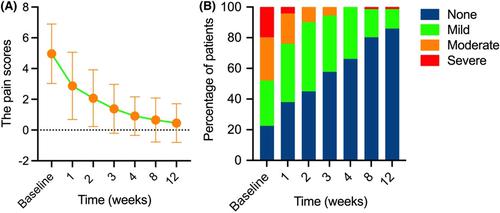当前位置:
X-MOL 学术
›
Cancer Sci.
›
论文详情
Our official English website, www.x-mol.net, welcomes your
feedback! (Note: you will need to create a separate account there.)
Risk-adapted stereotactic body radiotherapy for patients with cervical spinal metastases
Cancer Science ( IF 4.5 ) Pub Date : 2022-09-02 , DOI: 10.1111/cas.15559 Huan-Huan Wang 1 , Shou-Sen Tian 1 , Jia-Min Yang 1 , Bing-Sheng Sun 2 , Ying Chen 3 , Yong-Chun Song 1 , Yang Dong 1 , Jing-Sheng Wang 1 , Zhi-Yong Yuan 1 , Yao-Li Cui 4 , Mao-Bin Meng 1
Cancer Science ( IF 4.5 ) Pub Date : 2022-09-02 , DOI: 10.1111/cas.15559 Huan-Huan Wang 1 , Shou-Sen Tian 1 , Jia-Min Yang 1 , Bing-Sheng Sun 2 , Ying Chen 3 , Yong-Chun Song 1 , Yang Dong 1 , Jing-Sheng Wang 1 , Zhi-Yong Yuan 1 , Yao-Li Cui 4 , Mao-Bin Meng 1
Affiliation

|
Owing to the complex anatomical structure and biomechanics, the current standard palliative treatments for cervical spinal metastases are associated with a high risk of recurrence and complications. Stereotactic body radiotherapy (SBRT) can provide radical dose to tumors while protecting normal organs to the maximum extent. However, the efficacy and safety of SBRT for cervical spinal metastases is not well characterized. Data from 71 patients with cervical spine metastases who were treated with SBRT using CyberKnife between 2006 and 2021 were obtained from our prospectively maintained database. Primary endpoint was pain response at 12 weeks following SBRT completion; secondary endpoints included local control (LC), overall survival (OS), and adverse events. Standard-risk patients were planned to receive 30 Gy (range 21–36) with median fractions of 3 (range 1–3) and high-risk patients 35 Gy (range 24–50) with median fractions of 5 (range 4–5) according to the spinal cord and esophagus dose constraints. The median follow-up time was 17.07 months (range 3.1–118.9). After 12 weeks of SBRT completion, 54 (98.2%) of 55 patients with baseline pain achieved pain response and 46 (83.6%) achieved complete pain response. LC rates were 93.1% and 90% at 1 year and 2 year, respectively. The 1-year and 2-year OS rates were 66.2% and 37.4%, respectively. Eight patients experienced grades 1–4 adverse events (six vertebral compression fracture [VCF], five of them had VCF before SBRT; and two hemiparesis). No grade 5 adverse events were observed. Therefore, risk-adapted SBRT for cervical spine metastases achieved high pain control and LC rates with acceptable adverse events.
中文翻译:

颈椎转移瘤患者的风险适应立体定向放疗
由于复杂的解剖结构和生物力学,目前对颈椎转移瘤的标准姑息治疗与复发和并发症的高风险相关。体部立体定向放射治疗(SBRT)可以在最大限度保护正常器官的同时,对肿瘤提供根治剂量。然而,SBRT 治疗颈椎转移瘤的疗效和安全性尚未得到很好的表征。从我们前瞻性维护的数据库中获得了 2006 年至 2021 年间使用 CyberKnife 进行 SBRT 治疗的 71 名颈椎转移患者的数据。主要终点是 SBRT 完成后 12 周时的疼痛反应;次要终点包括局部控制(LC)、总生存(OS)和不良事件。标准风险患者计划接受 30 Gy(范围 21-36),中位分数为 3(范围 1-3),高危患者接受 35 Gy(范围 24-50),中位分数为 5(范围 4-5 ) 根据脊髓和食管剂量限制。中位随访时间为 17.07 个月(范围 3.1–118.9)。在 SBRT 完成 12 周后,55 名基线疼痛患者中有 54 名 (98.2%) 获得疼痛反应,46 名 (83.6%) 获得完全疼痛反应。1 年和 2 年的 LC 率分别为 93.1% 和 90%。1 年和 2 年 OS 率分别为 66.2% 和 37.4%。8 名患者经历了 1-4 级不良事件(6 名椎体压缩性骨折 [VCF],其中 5 名在 SBRT 前发生 VCF;2 名出现偏瘫)。未观察到 5 级不良事件。所以,
更新日期:2022-09-02
中文翻译:

颈椎转移瘤患者的风险适应立体定向放疗
由于复杂的解剖结构和生物力学,目前对颈椎转移瘤的标准姑息治疗与复发和并发症的高风险相关。体部立体定向放射治疗(SBRT)可以在最大限度保护正常器官的同时,对肿瘤提供根治剂量。然而,SBRT 治疗颈椎转移瘤的疗效和安全性尚未得到很好的表征。从我们前瞻性维护的数据库中获得了 2006 年至 2021 年间使用 CyberKnife 进行 SBRT 治疗的 71 名颈椎转移患者的数据。主要终点是 SBRT 完成后 12 周时的疼痛反应;次要终点包括局部控制(LC)、总生存(OS)和不良事件。标准风险患者计划接受 30 Gy(范围 21-36),中位分数为 3(范围 1-3),高危患者接受 35 Gy(范围 24-50),中位分数为 5(范围 4-5 ) 根据脊髓和食管剂量限制。中位随访时间为 17.07 个月(范围 3.1–118.9)。在 SBRT 完成 12 周后,55 名基线疼痛患者中有 54 名 (98.2%) 获得疼痛反应,46 名 (83.6%) 获得完全疼痛反应。1 年和 2 年的 LC 率分别为 93.1% 和 90%。1 年和 2 年 OS 率分别为 66.2% 和 37.4%。8 名患者经历了 1-4 级不良事件(6 名椎体压缩性骨折 [VCF],其中 5 名在 SBRT 前发生 VCF;2 名出现偏瘫)。未观察到 5 级不良事件。所以,









































 京公网安备 11010802027423号
京公网安备 11010802027423号